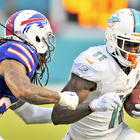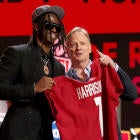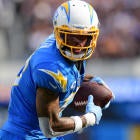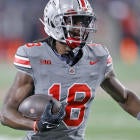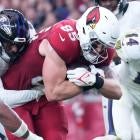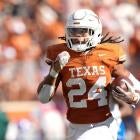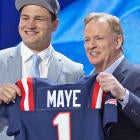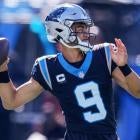Ask a player for how many yards and touchdowns he'll get before a season starts and he'll tell you numbers only he and his parents would believe are possible. One time a former Pro Bowl tight end told me he saw himself receiving for 1,000 yards and rushing for 1,000 yards in the same season. Side note: the tight end never had a 1,000-yard season in his career.
Asking anyone for stat projections is useless. Coaches won't do it and players will be frivolous. But peering into the tendencies of the coaches calling plays typically gives an idea of what to expect. Last season we were able to recognize patterns that suggested big seasons ahead for Doug Martin, Chris Ivory, Latavius Murray and a Falcons running back (Devonta Freeman was hurt at the time) while also calling out potential for the likes of Brandon Marshall, Sammy Watkins and Michael Crabtree.
Fantasy owners can get a lot of pre-draft help by analyzing what these coaches have done and what they should do this season. Ten teams made playcaller changes during the offseason -- let's see what we should expect from each of them.
Rob Chudzinski, Colts
Chud's career calling plays goes back to the University of Miami in 2001, but for this we'll just focus on his time in the NFL. That includes three years over two stints with the Browns, Cam Newton's first two seasons in Carolina and the last eight games last season with the Colts.
Average pass/run ratio: 57 pass/43 run
Only once, in 2012 in Carolina, did Chudzinski even come close to being balanced in his playcalling. He's all about the pass, even if he doesn't have a good quarterback. In his past 24 NFL outings -- eight with the injury-riddled Colts and 16 with the 2013 Browns -- he asked for an average of 40.3 passes per game.
Average RB carries: 21.1 per game
Don't take this to mean Chudzinski doesn't like to run the ball. Remember, a lot of his time was spent in Cleveland (where they didn't win much) and in Carolina (where Newton took the ball out of his running backs' hands often). To his credit he leaned on the Colts' backs 22.3 times per outing in '15 ... but Frank Gore had just three games with 10-plus Fantasy points with Ahmad Bradshaw adding another. Chud's willingness to forego the run combined with the concern over Gore's durability and performance make for a dreaded Fantasy scenario.
Receptions: leaning on the tight ends
It's clear one of Chudzinski's core beliefs is utilizing the tight end. On average he's seen his tight ends catch 27.2 percent of his team's passes. The only other offensive coordinator who has come close to this percentage is the last Colts playcaller, Pep Hamilton. Knowing this information, it should also tell you something about why the Colts let Coby Fleener go. Also, running backs (23.5 percent) get almost as much work as tight ends. Receivers have gotten the rest, which isn't a lot, but consider the teams he coached previously.
Bottom line: It should mean a huge year for Andrew Luck, who has attempted 38.3 passes per game in his career. With the Colts offensive line patched up, Luck should have a great shot at getting second-best career-high stats. Dwayne Allen is a sneaky good sleeper with a late-round pick while none of the Colts running backs should be targeted on Draft Day.
Adam Gase, Dolphins
Gase has jumped from Denver to Chicago to Miami in consecutive seasons, but last year was the first time where we saw more of what Gase wanted versus what he settled for when Peyton Manning was his quarterback. That's not to say Gase had total control -- John Fox probably urged a conservative approach. So have we really even seen a unilateral Gase offense?
Average pass/run ratio: 57 pass/43 run
That ratio is heavily weighted toward Gase's two seasons with the Broncos when Manning ultimately took control of the offense. For a more realistic number, Gase's Bears last season were 53 pass/47 run. Consider that the absolute floor for the Dolphins, who last season were 60 pass/40 run as they played from behind most weeks.
Average RB carries: 26.0 per game
At least this has been consistent over Gase's three seasons. He's definitely not shy to run the ball and his backs have gotten plenty of opportunities. It's more of a matter of who gets what. Until we see rookie Kenyan Drake deliver evidence of being a three-down back, this number should be welcome news for prospective Jay Ajayi Fantasy owners.
Receptions: playing to strengths
Gase is smart enough to lean on whoever his playmakers are. In Denver they were Demaryius Thomas and Emmanuel Sanders. In Chicago they were supposed to be Alshon Jeffery and Kevin White, but injuries forced him to go in other directions. Running backs have consistently had around 20 percent of the receiving work, which is where Drake might fit in the most.
Bottom line: Bank on the Dolphins receivers getting a lot of action this year. DeVante Parker truly could flourish. At running back, expect Jay Ajayi to get the first crack at leading the way behind a beefy offensive line. And don't buy the correlation between Gase's previous tight ends and the Fantasy appeal of Jordan Cameron. He's a target but far from the best one. Ditto that for Tannehill, though that's a much easier argument to buy because of who he's surrounded by.
Hue Jackson, Browns
Hue Jackson's been involved in pro football for a long time. His first offensive coordinator job was in Washington under Steve Spurrier, though Spurrier called those plays as per his unique offense. For our study we'll look at his time in Atlanta, Oakland and Cincinnati spanning five seasons.
Average pass/run ratio: 54 pass/46 run
This shouldn't be too surprising given the lack of great quarterbacks he's worked with strictly as a playcaller. That's not to say Andy Dalton is or isn't great but Jackson's two-year average in Cincy was 51 pass/49 run. You might expect the Browns to be forced into a lot of passing situations this season.
Average RB carries: 24.7 per game
Again, Jackson has always been a friend to running backs. Last season Jeremy Hill struggled mightily and Jackson still stuck by him for basically as many rush attempts as he had as a rookie. In Oakland, Darren McFadden and Michael Bush had Jackson's confidence. Already this offseason Jackson has seemed satisfied with Isaiah Crowell and Duke Johnson splitting the workload.
Receptions: more love for the running backs
Jackson has had a Chudzinski-esque 26.2 percent of his team's receptions go to running backs. That includes a 2010 year where running backs in Oakland accounted for 33.3 percent of the total catches! As for tight ends, the light bulb seemed to turn on for Jackson in Cincinnati thanks to Tyler Eifert. In his last two years Jackson's tight ends caught an average of 23.2 percent of the passes thrown their way.
Bottom line: There's serious potential for Duke Johnson (61 catches in '15) to have a monster year as a receiver out of the backfield. If you want to invest in a Browns running back, he's the one. Gary Barnidge should also stay afloat as a regular target. What about the receivers? Between their lack of experience and questions about how many looks they'll actually get, the only one worth a look in the late rounds in rookie Corey Coleman.
Terry Robiskie, Titans
An NFL coach since 1982, Robiskie gets his first shot at calling plays since 2004 in Cleveland. He's worked with the likes of Marcus Allen and Bo Jackson in his time with the Raiders. He was also a passing game coordinator in Washington during Norv Turner's last two years there, but we're not counting that in the study since he had zero responsibilities with the run game.
Average pass/run ratio: 51 pass/49 run
Welp, if there's a coach who fits into the whole "exotic smashmouth" offense Mike Mularkey is going to try and build in Tennessee, it's Robiskie. Granted, his years as a play caller involved some really good running backs, but he even stuck with a balanced approach when he was in Cleveland with the likes of William Green and Lee Suggs at running back!
Average RB carries: 28.6 per game
That high number could be construed as misleading since much of Robiskie's calling of plays came in an era where league rules didn't dictate tons of passing. Now they do. Still, it's an indicator that is in lockstep with Mularkey's style. Mularkey rode backs like Michael Turner and Willis McGahee to big seasons, giving them lots of carries. Chances are the same thing will happen this season in Nashville.
Receptions: just take a guess
We've seen Robiskie lean on his running backs through two data points, so why not make it three? One-quarter of his teams' receptions went to running backs, and that does not include the 39.9 percent of catches made by his rushers in Washington when he was their passing game coach! On the flip side, tight ends have been taken down a notch by Robiskie, finishing with 20.6 percent of the total receptions. Receivers have consistently been involved.
Bottom line: Naturally all this points to a big year for DeMarco Murray and, by extension, Derrick Henry. If the Titans are going to stick with this run-the-ball-all-the-time thing then Murray should fall into production with Henry getting some nibbles along the way. Leaning on running backs more and throwing to tight ends less won't bode well for Delanie Walker. His blocking might be as valuable to the Titans as his hands.
Chip Kelly, 49ers
How soon can an old dog learn new tricks? If Kelly keeps his system similar to what he did in Philadelphia then he's going to encounter some trouble. Ten of the 49ers' 2016 opponents played his Eagles in 2015. All of the numbers you'll see are from Kelly's time in Philly.
Average pass/run ratio: 55 pass/45 run
Kelly himself will tell you he'd prefer for this number to be closer to 50-50. That's just about where he was at in 2013 when his unique system breeded some success. His last two years saw him lean much heavier toward the pass.
Average RB carries: 25.7 per game
You can hang your hat on this number -- Kelly's running backs in Philly oscillated between 25.0 and 26.3 rushes per game. Always in that range. It just so happened that in his more recent contests Kelly had to call more pass plays but did so without forgetting about his rushers. That's a benefit of his up-tempo offense.
Receptions: trends favor strengths
Kelly's tight ends saw consistent amounts of work in his offense, catching a good average of 24 percent of the receptions per year. But in 2015 his running backs took on more work (31.7 percent) while his receivers trailed off (43.5 percent). Considering how wacky those numbers were compared to the averages over his first two seasons (19.4 percent for running backs, 57.1 percent for receivers), one could surmise Kelly realized just how putrid his receivers were and channeled more work for others.
Bottom line: Just wait until Kelly looks at his receiving options in San Francisco: Torrey Smith, Bruce Ellington and Quincy Patton. Don't expect those guys to suddenly morph into 1,000-yard superstars. It should mean more work for his tight ends but the guy who could touch the ball over 300 times is Carlos Hyde. He's already lost some weight in anticipation of a very busy season -- there's all kinds of positive potential with him. Just make sure you draft his backup.
Doug Pederson, Eagles
Pederson has never been a full-time playcaller in the pros. He shared back in January that he took over the Chiefs playcalling in the second-halves of their last 12 games, but it might not be fair to judge him based on that data alone. What's more reliable is to base Pederson on the type of offense he's grounded in, which is Andy Reid's version of the West Coast system. It's a conservative doctrine with a lean toward the run game -- last season the Chiefs were 51 pass/49 run. It seems to be a formula perfect for the Eagles considering their quarterbacks -- an injury prone veteran and a rookie who played his collegiate ball at a FCS school. The running backs, led by Ryan Mathews, should benefit as might the sure-handed catch-and-go guys like Jordan Matthews and Zach Ertz.
Ken Whisenhunt, Chargers
Quite possibly the best offensive coordinator change was made in San Diego. Whisenhunt gets the chance to pick up where he left off with the Chargers when he took the Titans head coaching job two years ago. He basically abandoned the run game in his two seasons in Tennessee, averaging 18.5 running back carries per game. That's nearly 10 carries fewer than his backs had in San Diego in 2013 -- a large 27.9 per game! Whisenhunt was also part of the crew who brought in and maximized the talents of Danny Woodhead. Most people know what to expect from the Chargers passing game but if he can get Melvin Gordon rolling then the Chargers will definitely run a lot. That's a big if.
Ken Zampese, Bengals
The son of long-time coach Ernie Zampese, who was part of the Air Coryell design and implementation in the 1970s and 80s, Ken Zampese is getting his very first chance to call plays in the NFL. In fact, he's only been an offensive coordinator for one season of his life -- at Northern Arizona University in 1995. Now before that scares you away from drafting any Bengals, keep in mind that Zampese has been with Marvin Lewis and the Bengals for a long, long time. Since 2003, to be exact. He's been close with Dalton through his career, so it certainly would make sense for the offense to stay the same but flow through the quarterback a little more than when Hue Jackson was calling the shots.
Dowell Loggains, Bears
Loggains spent last season as the Bears quarterbacks coach and previously was the offensive coordinator in Tennessee for 21 games under then-coach Mike Munchak. In those games he was 54 pass/46 run with a heavy lean toward his receivers getting receptions (over 61 percent of all catches). That bodes very well for Jay Cutler and his potential-filled duo of Alshon Jeffery and Kevin White. However, John Fox is a conservative coach and probably will ask/demand Loggains to keep the run involved. That task isn't quite as easy without Matt Forte in town, but if Jeremy Langford improves his game and/or if Jordan Howard shines as a rookie then it'll be a simple task for Loggains.
Rob Boras, Rams
Boras is the offensive coordinator but Mike Groh is the team's passing game coordinator. Perhaps the first question you'll ask is "Who are these guys?!" Boras is a former offensive line and tight ends coach, Groh is a former quarterback and former collegiate offensive coordinator. To say these guys have a lot of good experience would be a lie -- Groh had three years calling shots for the Cavaliers and Boras has all of four games' worth of experience with the Rams (he was 44 pass/56 run). It's safe to say the Rams will be conservative on offense and lean on Todd Gurley as much as possible.













